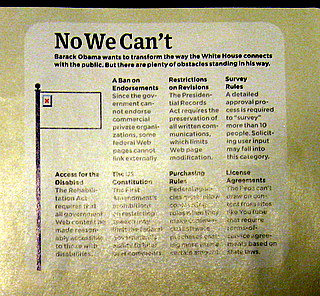Last month's Wired magazine had an interesting article on what we should expect of the new Obama administration in terms of transparency of government by using the web. One of the callout features specifically addressed the obstacles that might prevent the administration from fully utilizing Web 2.0 technology. Listed among those is "Access for the Disabled."

As those of use working in this field know, creating accessible content is not only generally relatively easy, but is also just part of good design. Wired's irresponsible and inaccurate characterization of access for the disabled being an obstacle may reflect a broader myth popular with the technical community, and that is what is truly unfortunate about it.
As those of use working in this field know, creating accessible content is not only generally relatively easy, but is also just part of good design. Wired's irresponsible and inaccurate characterization of access for the disabled being an obstacle may reflect a broader myth popular with the technical community, and that is what is truly unfortunate about it.
Enabling the base level of access necessary to keep you on the right side of the law is relatively easy. The government needs to set an example of how enabling access isn't an obstacle, it just requires a small amount of forethought.
